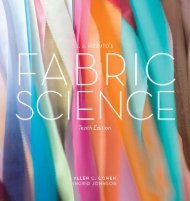Visual Merchandising Display - Fairchild Books
Visual Merchandising Display - Fairchild Books
Visual Merchandising Display - Fairchild Books
You also want an ePaper? Increase the reach of your titles
YUMPU automatically turns print PDFs into web optimized ePapers that Google loves.
interiors—like an Abercrombie & Fitch store. The lamps<br />
are available in correlated color temperatures ranging from<br />
3,000 to more than 20,000 K (kelvin). With “pulse start”<br />
technology, there is improved color rendition, and the K<br />
variance is plus or minus 100 K.<br />
PAR and Ceramic Compact Metal Halide (CDMT)<br />
lamps now produce four times more light than a halogen<br />
lamp of the same energy, and it is also possible to control<br />
glare and focus better with CDMT lamps because they can<br />
be used with reflectors and lenses. As of now, the size of the<br />
CDMT lamp makes it difficult to use in some areas, but the<br />
lighting companies are working on making the fixtures and<br />
reflectors smaller and more adaptable to other uses.<br />
Ceramic Metal Halide Lamps<br />
This is a variation on the old mercury vapor lamp. A ceramic<br />
tube containing mercury, argon, and metal halides is used,<br />
and the electric charge is introduced. The metal halide salts<br />
are partially vaporized, and inside the hot plasma, the salts<br />
are disassociated into metallic atoms and iodine. The temperature<br />
within the tube can be greater than 1,200 K.<br />
The metallic atoms produce a bluish light that is close<br />
to daylight, with a color rendering index (CRI) of 96. It is<br />
also possible to get warm-white lamps with a 78 to 82 CRI.<br />
Some manufacturers, including General Electric, are producing<br />
ceramic metal halide lamps like the new 23-watt GE<br />
ConstantColor CMH Integral PAR38. This lamp provides<br />
excellent energy savings and can be used for ambient and<br />
display lighting in retail settings. The lamps are available<br />
as 10-degree spots, 25-degree floods, and 36-degree wide<br />
floods with a warm, 3,000 K color temperature.<br />
Eye Lighting International of North Carolina produces<br />
a line of Cera Arc ceramic metal halide lamps with 39-, 70-,<br />
and 150-watt ratings. These feature an R9 value of 90 and a<br />
CRI rating of 92—high ratings in the industry. According<br />
to the manufacturer, “These values create rich colors, especially<br />
red, which is the most important color in retailing.”<br />
Rated at 3,600 K, the Cera Arc blends well with fluorescents<br />
and, in addition to the brilliant reds, offers great greens,<br />
blues, and white—all essential in showcasing clothing, jewelry,<br />
and flowers.<br />
40<br />
LED (Light-Emitting Diode)<br />
P a r t 1 : G e t t i n G S ta r t e d — V i S u a l M e r c h a n d i S i n G a n d d i S P l ay B a S i c S<br />
LED is the new kid on the block and one to contend with.<br />
It is being heralded and adapted most readily for all sorts<br />
of uses. Its small size, long life expectancy, and adaptability<br />
make it a popular choice, especially when accessibility to<br />
the light source and maintenance are involved.<br />
LEDs are solid-state devices that, unlike an incandescent,<br />
do not require heating of a filament to create light.<br />
The electricity passes through a chemical compound that<br />
is excited and then generates light. LED lighting requires<br />
a circuit board that allows electricity to pass through it<br />
at a specified current and voltage. The circuit board also<br />
requires the components that allow the LED to operate at<br />
voltages such as 12 Vdc, 24 Vdc, or 120 Vdc.<br />
General Electric has come up with a new LED module<br />
that simplifies LED lighting in directional applications, such<br />
as recessed downlights, tracks, pendants, and sconces. Small<br />
and puck shaped, the twist makes it easy to upgrade LED<br />
lighting with a simple twist of the module into the socket.<br />
The LED’s current popularity is due to its broader life<br />
expectancy. It also has no toxic elements. LEDs can last<br />
30,000 to 100,000 hours, compared with incandescents<br />
and halogens, which last from 2,500 to 5,000 hours. LED<br />
PAR20 floods and spotlights (7 watt) can be used for shop<br />
interiors. Color rendition is improving, and colors in the<br />
white and blue spectrum are getting brighter and warmer.<br />
With its multiple colored light possibilities, LED is being<br />
used for creating color effects in wall washing and signage.<br />
Some of the benefits associated with LED have been<br />
outlined by Environmental Lighting Company, a resource<br />
for these lighting products:<br />
u Extremely low power consumption<br />
u Extremely long life (50,000 to 100,000 hours)<br />
u Durable and insensitive to vibration<br />
u Dimmable and programmable<br />
u Lightweight and compact<br />
u Color without the use of filters or lenses<br />
u No reflectors required to direct light<br />
u Environmentally friendly<br />
u No mercury or other toxic elements<br />
u Recyclable













